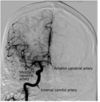Stroke COPY Flashcards
What is the definition of a stroke?
- CNS infarction
- Based on evidence of:
- Focal ischaemic injury in vascular distribution
- Clinical evidence
- With other causes excluded
What happens to the brain when a stroke occurs?
- Blood flow stops
- Neurones depolarised
- Onset of early symptoms
- Brain tissue dies
How can more brain death be prevented in stroke?
By restoring the blood flow as soon as possible
Draw a diagram of the circle of willis





If there is right sided body weakness, which part of the brain is affected?
Left cerebral hemisphere


What will a stroke of the middle cerebral artery cause?
Face and arm weakness


Where is Brocas area of the brain?
What is its function?
Left frontal lobe
Speech production
What is Wernickes area?
What is its function?
Posterior superior temporal gyrus
Understanding and producing meaningful speech


What visual change would occur with a stroke in this area?

Right homonymous hemianopia

If a patient came in with acute light-headedness with past-pointing and nystagmus, where would the stroke be?
Cerebellum

F.
What is pictured here?

Harmorrhagic stroke on the left
Ischaemic stroke on the right
How do you differentiate between different types of stroke?
MRI head
What is an ischaemic stroke?
Episode of neurological dysfunction caused by an infarction
What are some of the causes of ischaemic stroke?
- Cryptogenic
- Cardiac embolism
- Small vessel disease
- Atherosclerotic cerebrovascular disease
What are the different categories of stroke under the Oxford community stroke project?
- Total anterior circulation syndrome (TACS)
- Partial anterior circulation syndrome (PACS)
- Posterior circulation syndrome (POCS)
- Lacunar syndrome (LACS)
Describe TACS?
- Usually proximal MCA or ICA occlusion
- Hemiparesis
- Hemianopia
- Higher cortical dysfunction
Describe PACS?
- MCA branch occlusion
- Isolated higher cortical dysfunction
- OR
- Any 2 of hemiparesis, higher cortical dysfunction, hemianopia
Describe POCS?
- Perforating arteries, PCA or cerebellar arteries
- Isolated hemianopia
- OR
- Brainstem syndrome
Describe LACS?
- Small vessel disease
- Pure motor stroke
- Pure sensorys troke
- Sensorimotor stroke
- Ataxia hemiparesis
- Clumsy hand-dysarthria


What is the definition of an intracerebral haemorrhage?
Collection of blood within the brain parenchyma or ventricules that is not caused by trauma.
What is the definition of stroke caused by intracerebral haemorrhage?
Rapidly developing clinical signs of neurological dysfunction attributable to a focal collection of blood within the brain parenchyma or ventricular system that is not caused by trauma.
What are the causes of intracranial bleeds?
- Trauma
- Tumours
- Small vessel disease
- Cocaine / Amphetamines
- Blood clotting deficiencies
Describe the management of an ischaemic stroke?
- Aspirin
- Stroke unit
- IV thrombolysis
- Hemicranectomy
Describe the management of an haemorrhagic stroke (due to intracerebral bleed)?
- BP control
- Stroke unit
- Neurosurgical evacuation
Describe hyper-acute treatments for ischaemic stroke?
- Thrombolysis
- Within 4 hours of symptom onset
- Thrombectomy
- Within 8 hours of symptom onset
- Stroke unit
- Prevent aspiration
What explains most causes of ischaemic stroke?
Cerebrovascular risk factors
Name some cerebrovascular risk factors?
- High BP
- Obesity
- Smoking
Describe potential investigations into stroke?
- CT (1st line)
- MRI if diagnostic doubt
- Duplex US of carotid and vertebral arteries
- Intra-arterial angiography
Clinical features of stroke?
- Weakness
- Speech disturbance
- Ataxia (if cerebellum involved)
Describe an ischaemia stroke?
- Thromboembolic disease
- Secondary to atherosclerosis in the major extracranial arteries
- Carotid, aortic arch
Describe a haemorrhagic stroke?
- Rupture of a blood vessel within the brain parenchyma
- Can occur in SAH if the artery ruptures into the brain substance as well as the subarachnoid space
Name some structural stroke mimics?
- Cerebral tumours
- Extradurall/subdural haematoma
- Cerebral abscess
Name some functional stroke mimics?
- Hypoglycaemia
- Focal seizures
- Migranous aura
What is a TIA?
- Symptoms resolve within 12 hours
- Includes amaurosis fugax
What is a progressive stroke?
- Focal neurological deficit worsens after the patient presents
- Increasing infarction volume, increasing cerebral blood/oedema
What is a completed stroke?
Focal deficit persists but does not worsen
Management flow chart for stroke

Management of secondary stroke risk factors



